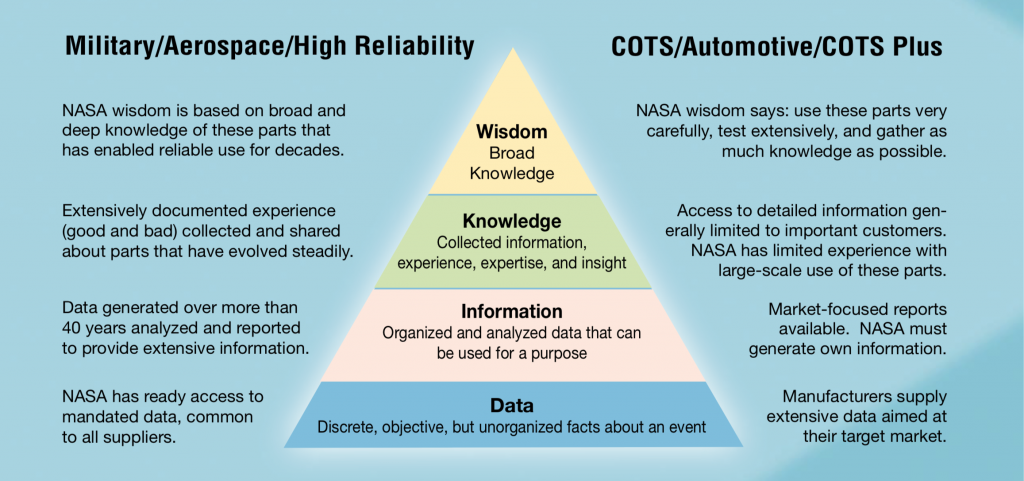COTS+ brings better components to market, faster
A rising tide lifts all boats: Twenty-five years after the off-the-shelf revolution, a new approach to creating high-quality products is emerging.
It’s a basic R&D quandary: How can product standards keep pace with emerging technologies and burgeoning demands? Or how does an industry keep a regulatory structure from standing in the way of innovation and implementation?
It was that challenge that faced the U.S. Department of Defense (DoD) in the early 1990s, when there were some 30,000 stringent military standards or MIL-STDs. With costs rising, the time to develop MIL-STDs for new products was long and with digital technologies coming quickly onstream, Secretary of Defense William Perry responded in 1994 by issuing a watershed memo that cancelled the need for many military specifications and standards. In their stead, the DoD directed the use of performance specifications that described the desired efficacy of a weapon or system rather than which technology or materials would be used to accomplish the goal.
In essence, the so-called Perry Memo opened the door to Commercial-off-the-Shelf (COTS) components—parts designed for commercial applications where the manufacturer or vendor establishes and controls the specifications for performance, configuration and reliability with no additional, external requirements. COTS quickly became known as an efficient way to reduce the cost and time associated with software development.
MIL vs Commercial component selection system comparison. Source: NASA NESC Technical Update 2014, “COTS Components in Spacecraft Systems: Understanding the Risk“
It’s widely recognized that the move to COTS boosted participation by small companies in defense programs, saved the government billions of dollars, promoted the use of open standards, and allowed the introduction of new technology.
But the afterglow was relatively short lived. While it was clear that the adoption of COTS had allowed the defense industry to leverage the quality, time-to-market and innovation of the industrial, medical and automotive sectors, within two decades, observers were vocal about the need for an additional evolutionary step.
Beyond COTS
Enter COTS+, a phrase coined by Rantec, the California-based military power developer, to represent its military-grade high density module. For Rantec, the “plus” represented a more rugged design and the fact that the commercially available product had been tweaked to meet military specifics, a process now known as up-screening.
More broadly, Dr. Tomáš Zedníček of the European Passive Components Institute has defined COTS+ as having the “COTS part supported by test data that’s available to end-users, who can establish random failure-rate assumptions, performance that’s consistent with the manufacturer’s data sheet and methods to exclude infant mortal parts, parts with latent defects, weak parts, or counterfeit parts.”
The call for COTS+ up-screening is growing. Today, manufacturing a component or part is not enough. Within the defense sector, there are demands for manufacturers to satisfy stricter standards and meet greater challenges related to temperature, humidity or vibration while still falling under the “off-the-shelf” classification. In effect the definition of adopting COTS+ can be “maintaining the time to market” while also “making it better” and perhaps “being able to prove it.”
Two other recent trends are also driving the need to bring high-quality components to market without the cost or time associated with meeting MIL-STDs. Both the nascent commercial space tourism programs of SpaceX, Boeing, Blue Origin and Virgin Galactic, as well as the emerging “New Space” market opportunities, and the rapid development of autonomous or semi-autonomous surface vehicles are increasing the demand for new materials, optical components, and systems that rely on developments in nanotechnology. With competition rife in both of these emerging areas, there is increasing pressure to reduce cycle times and keep costs down, while ensuring that quality controls remain intact.
For space- and defense-related components and sub-systems companies like Teledyne e2v, this means they can provide, develop and also help other companies up-screen their components to COTS+. This includes making components launch tolerant, resistant to temperature and vibration and extremes of shock, and able to withstand ionized radiation levels specific to either low earth orbit or geostationary positioning. Cost efficiencies are introduced, for example, by up-screening only those image sensors within a batch that are required to be COTS+, and then only as much as is deemed required for the intended application.
Quality at the Core
Considering the pressures on industry to meet the growing demand for up-screened parts, Dr. Zedníček outlined some key considerations in a 2016 paper:
- Quality must be manufactured, not up-screened. The parts-per-million failure level of the technology will be the same as the original commercial product.
- Burn-in is not mandatory for commercial parts.
- The main purpose of COTS+ is to remove infant failures, minimize the risk of maverick lots/parts and quantify the individual batch reliability level using statistical tools like Weibull analysis and stress-factor calculations.
- Given that statistical tools like Weibull were set up for relatively high levels of catastrophic failures that regularly occurred on older components under accelerated conditions, new technologies may need to use higher acceleration stress factors to see catastrophic failures and make the life prediction calculations.
- When considering COTS+ parts and devices, the parametric shift is of more serious concern than catastrophic failures.
As he noted, if developers are to both leverage benefits and mitigate risks, COTS+ production requires rigorous, best practice manufacturing processes, with an elevated focus on quality.
Numerous manufacturers have initiated COTS+ programs across various sectors, enabling rapid development, quick technology insertion and improved management of capabilities for their core customer sets. Across the spectrum, the companies that are moving into this emerging area are working to find new efficiencies, such as eliminating the requirement for customer-specific drawings and implementing tests and inspections to provide accelerated screening to eliminate defects.
Approaching the quarter-century anniversary of William Perry’s sea change in the military supply chain, COTS+ holds enormous promise for both growing commercial users and a defense industry facing new challenges around the world.




 Keeping an eye on our galaxy: an overview of satellites
Keeping an eye on our galaxy: an overview of satellites  Looking UP: Space-Based Satellites That Feed our Fascination with the Universe
Looking UP: Space-Based Satellites That Feed our Fascination with the Universe 